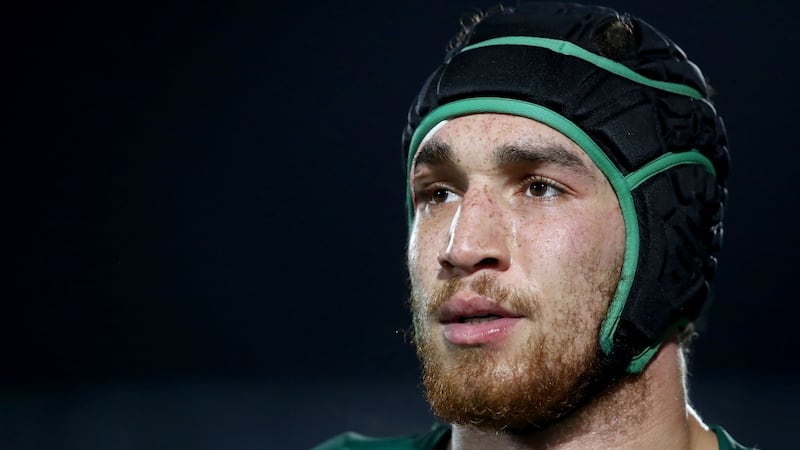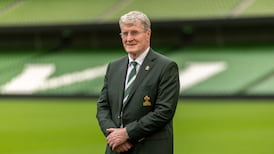Injury changes the landscape in sport. A month ago a rugby narrative pondered how Ireland could shoehorn James Ryan, Devin Toner, Iain Henderson and Tadhg Beirne into a matchday 23 – an embarrassment of riches to tax Joe Schmidt and his coaching group. Publicly, the picture appears bleaker now as one by one Ireland's tall pines have been felled by injury.
Devin Toner rolled his ankle on Saturday, a recurrence of the issue that saw the seemingly indestructible secondrow sidelined for a period in December and early January. If he is ruled out of Ireland’s game against Scotland at Murrayfield on Saturday (2.15) he will join Henderson (finger) and Beirne (knee) in a watching brief.
Ireland head coach Joe Schmidt briefly referenced depleted resources in his post-match analysis. Toner's potential absence – he calls Ireland's lineout – would mean that James Ryan or Peter O'Mahony would have to assume the role. Munster captain O'Mahony was the primary source of possession out of touch on Saturday, with the ball thrown to him over 50 per cent of the time (six) while also managing to pinch an English throw.
Connacht's Quinn Roux replaced Toner and put in some meaty tackles. Originally left out of Schmidt's extended 38-man Irish squad for the opening couple of rounds of the Six Nations Championship, Roux leapfrogged his provincial teammate Ultan Dillane to make the bench for the England match.

Noted for his work in the tight and the scrum, the 28-year-old has made four starts, the last against Italy in Chicago, in his nine appearances for Ireland since making his debut in 2016. Scotland will present a different physical challenge and also in terms of their attacking orientation, so Dillane's (11 caps, two starts) athletic credentials will definitely merit a discussion.
Consistent excellence
The 25-year-old burst onto the Test match stage against England at Twickenham in 2016, going on to play eight times – seven from the bench, including Ireland's victory over New Zealand in Chicago. The emergence of James Ryan and latterly Beirne and the consistent excellence of Toner and Henderson, coupled with a loss of form and the death of Dillane's mother, Ellen, last year represented significant personal challenges.
Beirne was slated to miss the first two matches in the Six Nations with a medial knee ligament injury
Speak to anyone involved in Connacht rugby and they'll offer testimony to his consistent excellence for Andy Friend's team this season. What Dillane brings is athleticism and an unrelenting physicality on both sides of the ball. His last appearance in a Six Nations match is nearly two years ago to the day, coincidentally against Scotland, when coming on as a replacement.
Beirne was slated to miss the first two matches in the Six Nations with a medial knee ligament injury, while Henderson’s damaged finger would sideline him for several weeks; although, given the speed with which he came back from thumb surgery, both could be back in the mix in time for the game against Italy at the end of the month.
Or not, as the case may be. In looking further down the pecking order of what has become an endangered species given the litany of lock injuries, Ulster's Kieran Treadwell, the Dublin-born Connacht secondrow Gavin Thornbury and Munster's Billy Holland may be called upon.
Treadwell swapped Harlequins for Ulster via a loan period with London Scottish, having played underage rugby for both Ireland and England. Schmidt gave him a debut on a summer tour to Japan and the USA in 2017, where he played twice, before winning a third cap in 2017 against Fiji. He has been maturing under the guidance of Dan McFarland at Ulster.
Development contract
Thornbury, 25, is uncapped but the six-foot, eight-inch secondrow was brought into an extended Irish squad last August. Injury prevented him from taking an active part but he appreciated the opportunity to familiarise himself with the environment.
The former Blackrock schoolboy was part of the Leinster academy, highly regarded too to a point where he was offered a development contract, but injuries curtailed his involvement. In a bid to get some game time he opted to go to New Zealand to play club rugby with the Border club, facilitated by Leinster old boy Kurt McQuilkin, and his performances saw him selected for the Whanganui provincial team that won the Heartland Championship.
Toner may recover in time or perhaps Beirne or Henderson possess Lazarantine genes
He returned to UCD to complete his studies and in 2017 was approached by Connacht, whom he agreed to join, and last October signed a two-year contract extension. He's quick, mobile, an excellent lineout option and his game under Connacht forwards' coach Jimmy Duffy has developed.
Holland, 33, won his only cap to date against Canada in 2016, but anyone who has seen him play for Munster this season won't have any doubts about his capacity to fulfil a role. The fact that no new players were added to the Ireland squad in the wake of the injuries suggests that Toner may recover in time or perhaps that Beirne or Henderson possess Lazarantine genes.
But what it does confirm is that the injuries can propel a player from the periphery into the squad and that Schmidt’s process in bringing players in to Ireland training camps helps to mitigate those times when it’s enforced rather than by choice.











